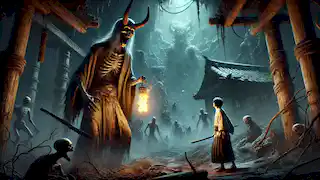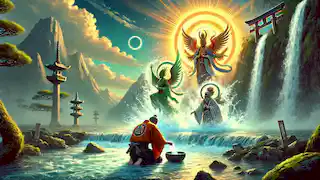The Myth of Izanagi and Izanami
Reading Time: 7 min

About Story: The Myth of Izanagi and Izanami is a Myth from japan set in the Ancient. This Dramatic tale explores themes of Loss and is suitable for All Ages. It offers Cultural insights. A tragic tale of creation and the eternal balance between life and death.
{{{_intro}}} In the ancient Japanese mythology, two primordial deities, Izanagi and Izanami, are credited with the creation of the world and the birth of gods and goddesses. This epic tale is one of love, loss, creation, and separation, told across generations in Japan’s ancient chronicles, the "Kojiki" and "Nihon Shoki." The story speaks to the intricate balance between life and death, the male and female forces of the universe, and the mysteries of the afterlife. As the creators of the islands of Japan, the tragic relationship between Izanagi and Izanami embodies the harmony and discord present in all living things. In the beginning, the world was shrouded in chaos, a vast, formless void. The heavenly deities, also known as the Kotoamatsukami, looked upon the swirling, untamed energies of creation and felt the need to impose order. They summoned two divine beings: Izanagi, the male god, and Izanami, the female goddess. Together, these two deities were entrusted with the task of bringing stability to the chaotic realm. The Kotoamatsukami gifted Izanagi and Izanami a sacred spear, the Ame-no-Nuboko, adorned with heavenly jewels. With this spear, the two deities ascended to the Floating Bridge of Heaven and peered down at the swirling seas below. Izanagi dipped the spear into the chaotic waters, and as he pulled it out, drops of water solidified into land. Thus, the first island, Onogoro, was born. With excitement and reverence, Izanagi and Izanami descended to Onogoro to fulfill their divine mission of creation. They built a pillar, the Ame-no-Mihashira, around which they would perform a sacred marriage ritual. This was to be the beginning of their journey to create more islands and fill the world with life. However, the first attempt at their union did not go as planned. When Izanami spoke first during the ritual, a grave error was made according to the divine law. As a result, the first children they created were malformed, creatures that did not have the intended beauty or grace. Saddened, they sought guidance from the Kotoamatsukami, who instructed them to repeat the ritual but this time with Izanagi speaking first, as tradition dictated. Following this divine instruction, they tried again. This time, their union was successful, and they began to create the islands that would form Japan. The islands Awaji, Shikoku, Oki, Kyushu, and Honshu emerged from the waters, forming the land of the rising sun. Izanami and Izanagi continued their divine task, creating the mountains, rivers, trees, and all manner of natural life. As the world grew in beauty and complexity, Izanami and Izanagi set their sights on populating it with gods and goddesses to rule over the various aspects of life. Izanami soon became pregnant with a child who would become Kagutsuchi, the god of fire. However, the birth of this fiery deity would prove to be fatal. As Kagutsuchi emerged into the world, his flames consumed Izanami, severely burning her. Despite the divine nature of the gods, even they were not immune to the dangers of life and death. In her final moments, Izanami’s divine essence began to fade, and she succumbed to her wounds. Izanagi, heartbroken and filled with rage, killed the newborn Kagutsuchi in his fury, splattering his blood across the heavens. From Kagutsuchi's blood, several more gods were born, but the world had lost Izanami, the great mother goddess. The grief-stricken Izanagi could not bear the loss of his beloved and decided to journey to the underworld, known as Yomi, to retrieve her. Yomi was a dark and eerie place where the dead resided, a shadowy realm from which few ever returned. Determined to reunite with Izanami, Izanagi descended into the depths of Yomi. As he ventured into the underworld, the light of the living world faded, and he was surrounded by the cold and oppressive darkness of the dead. The stench of decay hung in the air, and strange, ghastly beings lurked in the shadows. But Izanagi pressed on, his love for Izanami giving him the strength to face the terrors of Yomi. Finally, Izanagi found his beloved wife, but she was not the same as when he had last seen her. The land of the dead had claimed Izanami, and she warned Izanagi not to look upon her, for her body had decayed. Despite her warning, Izanagi's curiosity and longing overcame him. In a moment of weakness, he lit a torch to see her face. What he saw horrified him — Izanami's once beautiful form had rotted, and maggots crawled through her flesh. Izanami, enraged by his betrayal, ordered the creatures of Yomi to pursue him. Terrified, Izanagi fled the underworld, chased by demons and spirits intent on dragging him back to the land of the dead. Izanagi ran as fast as he could, determined to escape the horrors of Yomi and return to the world of the living. As he neared the entrance to the underworld, he spotted a massive boulder. With all his strength, Izanagi pushed the boulder across the entrance, sealing Yomi and ensuring that the dead could not return to the realm of the living. On the other side of the boulder, Izanami called out to him, filled with rage and despair. She vowed to take a thousand lives each day in revenge for his betrayal. In response, Izanagi declared that he would ensure the birth of fifteen hundred lives every day, to counter her curse. Thus, the cycle of life and death was established, an eternal balance between creation and destruction. Heartbroken by the loss of his beloved wife and overwhelmed by the sorrow of their separation, Izanagi returned to the land of the living. He felt tainted by his journey to the underworld and sought to cleanse himself in a ritual bath. This act of purification gave birth to more gods, including Amaterasu, the goddess of the sun; Tsukuyomi, the god of the moon; and Susanoo, the god of storms. After the devastating separation from Izanami, Izanagi sought solace in the creation of new deities, continuing his mission of bringing life into the world. As he washed his face to cleanse the impurity of Yomi, three of the most important gods in Japanese mythology were born. From the washing of his left eye emerged Amaterasu, the radiant goddess of the sun, who would go on to become the ruler of the heavens and the ancestors of the Japanese imperial family. From the washing of his right eye came Tsukuyomi, the serene and calm god of the moon. Lastly, from his nose was born the tempestuous Susanoo, god of storms and the sea. Though Izanagi had created these new gods, he never forgot the pain of losing Izanami. His relationship with his children would be complex, especially with Susanoo, whose rebellious nature would cause chaos in the heavenly realms. Amaterasu, on the other hand, would shine as the bright light of the world, becoming the chief deity of the heavens and the central figure in Shinto mythology. Izanagi's creations were now the rulers of the celestial realms, and he retired to live in peace, leaving behind a world full of life, light, and gods. Yet, the sorrow of Izanami’s death would forever echo through the heavens, a reminder of the cost of creation and the inevitability of loss. The myth of Izanagi and Izanami is a tale of love, loss, creation, and the delicate balance between life and death. From their union came the islands of Japan, the natural world, and the gods who would govern it. Yet, their separation also introduced the concept of death, establishing an eternal cycle that governs the universe. This ancient myth not only explains the creation of Japan and its deities but also serves as a reflection of human life — a journey filled with moments of joy and sorrow, love and loss, life and death. In the end, Izanagi and Izanami's story is one of profound tragedy, but also of resilience, as their legacy continues to shape the cosmos.Introduction

The Birth of the World

The Tragic Death of Izanami
The Journey to Yomi
The Separation of Life and Death

The Birth of Amaterasu, Tsukuyomi, and Susanoo

Conclusion: The Eternal Balance

















